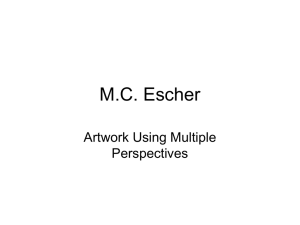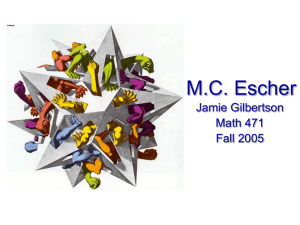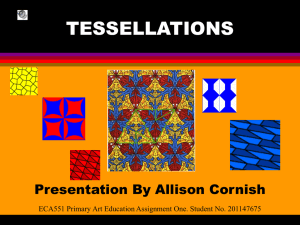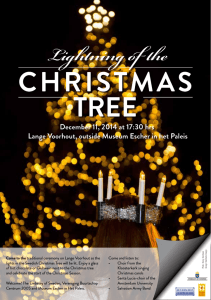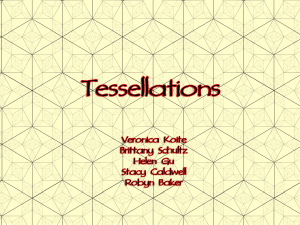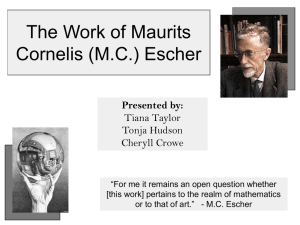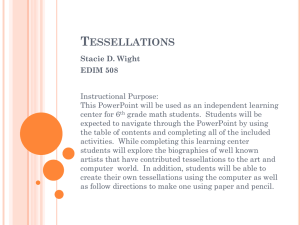TESSELLATIONS & M. C. Escher
advertisement
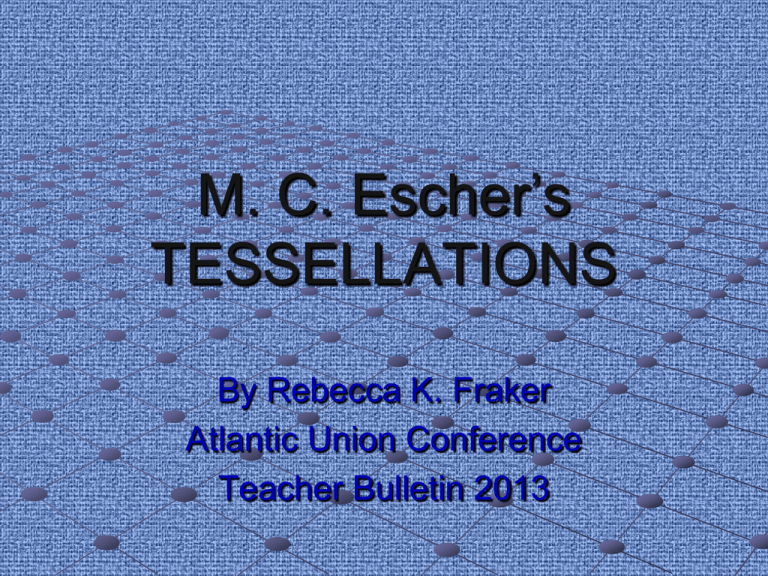
M. C. Escher’s TESSELLATIONS By Rebecca K. Fraker Atlantic Union Conference Teacher Bulletin 2013 What are Tessellations? The word 'tessera' in Latin means a small stone cube. They were used to make up the mosaic pictures forming floors and tilings in Roman buildings Tessellation refers a repetition of a shape or shapes that cover the surface of a plane without overlapping or leaving gaps. A Roman floor mosaic The Beginnings The tilings in the Alhambra in Spain were laid out by the Moors in the 14th century. They are not always pure tessellations Colored tiles formed patterns Many are truly symmetrical. They inspired young M.C Escher, who copied them into his notebooks and later converted some into true tessellations. Escher's drawing of Alhambra tiling. The Alhambra Palace, Granada, Spain, 12th-13th Century Reflective Symmetry noted in the lower tile patterns M. C. Escher Escher was born in Leeuwarden, Holland on June 17th, 1898. He was not a good student of math, yet he began to use mathematical patterns and relationships in his art after visiting the Alhambra Palace. 'Self Portrait in Chair' - 1920 M. C. Escher Escher produced '8 Heads' in 1922 - a hint of things to come. Look at the pictures from all angles if you can’t see all of them. '8 Heads' - 1922 Escher’s Last Tessellation His last tessellation was a solution to a puzzle sent to him by Roger Penrose, the mathematician. Escher solved it and changed the angular wood blocks into rounded 'ghosts'. Penrose 'Ghosts' - 1971 China Boy, 1936 Tessellation by M. C. Escher Squirrels, 1936 Tessellation by M. C. Escher Fish, 1938 Tessellation by M. C. Escher Design for Wood Intarsia Panel for Leiden Town Hall, 1940 Tessellation transitions by M. C. Escher Horsemen, 1946 Tessellation by M. C. Escher 4 Motifs, 1950 Tessellation by M. C. Escher Scarabs, 1953 Tessellation by M. C. Escher Fishes, 1958 Mural Tessellation mural by M. C. Escher Pegasus, 1959 Tessellation by M. C. Escher Birds, 1967 Tessellation by M. C. Escher Realism & Tessellations Combined Sometimes, M. C. Escher would combine realism and tessellations. Reptiles is an example of this combination. 'Reptiles' - 1943 Metamorphosis I, 1937 by M. C. Escher Realism & Tessellation Combined Cycle, 1938 by M. C. Escher Realism & Tessellation Combined Day and Night, 1938 by M. C. Escher Realism & Tessellation Combined Showing Mathematics in Art Escher died on March 27, 1972. He had produced 448 woodcuts, linocuts and lithos and over 2,000 drawings. M. C. Escher Rhomboid possibilities - 1937 notebook Copyright Laws Disclaimer Certain materials are included under the Fair Use Exemption of the U. S. Copyright Law and are restricted from further use. This presentation with images and web links is for educational use only. Escher’s art can be purchased many places. The information contained in this presentation is accurate to the best of my knowledge. As a resource, these websites were used: http://www.mcescher.com/ http://www.tessellations.org/ http://library.thinkquest.org/16661/escher.html http://www.herakleidon-art.gr/

